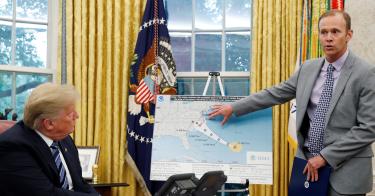The federal government is mobilizing its resources as Hurricane Florence bears down on the Southeast. Cleanup and recovery are likely to be enormously expensive, and if the president formally declares it a disaster, the federal government will foot most of the bill. In recent decades, though, such disaster declarations have proliferated, leaving the Federal Emergency Management Agency spread thin, and straining its resources. If the government is going to continue to meet the challenge of potentially catastrophic events like Florence, it will need to retune its approach to smaller-scale disasters, so that it can focus its attention where its aid is most desperately needed.
Through FEMA, the federal government covers 75 percent of disaster costs when the president issues a disaster declaration. The Stafford Act of 1988 requires these payments when a disaster is “of such severity and magnitude that effective response is beyond the capabilities of the State and the affected local governments and that Federal assistance is necessary.”
This vague standard, however, has had an unintended consequence. Rather than ensuring states are fully prepared to face disasters, the Stafford Act incentivizes states to be underprepared, so that even small disasters are considered “beyond the capabilities of the State.” Even local disasters centered entirely in one state and costing less than $5 million can be considered a disaster worthy of federalization.
This perverse incentive of significant federal money with a very low threshold has sparked a significant increase in the number of disasters that are federalized. The Reagan administration issued an average of 28 disaster declarations a year. George H. W. Bush averaged 43.5, Bill Clinton 89.5, and George W. Bush 129.6. Barack Obama issued about 107 declarations a year.
In addition to giving states the wrong incentives, these policies harm FEMA’s ability to do its job effectively. As FEMA worked to support recovery efforts after Superstorm Sandy and last year’s Hurricanes Harvey, Irma, and Maria, the Disaster Relief Fund (DRF) ran out of money and required supplemental appropriations.
Most years, the DRF has enough funding to cover FEMA’s ongoing obligations from past disasters as well as small- and medium-sized disasters that arise during the fiscal year. But when a big disaster strikes, the DRF often finds itself overleveraged. Congress is then called on to replenish the fund. These supplemental appropriations are political must-pass pieces of legislation. And politicians, being politicians, seldom miss the opportunity to tack all sorts of additional spending onto these bills. The result, too often, is a fiscally irresponsible “disaster relief” bill, packed with spending on completely unrelated issues that should be debated in the traditional appropriations process.
The proliferation of federal disaster declarations overwhelms more than just FEMA’s funding. It overwhelms the agency’s limited attention, as well. Each request for disaster funding must be adjudicated, FEMA officials deployed, and grants reviewed and overseen—all while navigating a minefield of regulations and rules on grants and government spending. This process can spread FEMA thin when it would prefer to focus on preparing for, and responding to, the biggest disasters.
FEMA’s current administrator, Brock Long, is looking for ways to incentivize state and local preparedness and return more responsibility to lower levels of government. For example, the agency is experimenting with turning over to Texas the responsibility for running the housing-recovery programs working to rebuild Houston. While the feds would continue to fund most of the work, the shift in management frees up FEMA officials to work on other issues.
Similarly, under the Obama administration, FEMA considered charging a “disaster deductible” to encourage states to be better prepared and more financially invested in disaster recovery. Long, like other FEMA officials before him, recognized that expecting FEMA to be engaged all the time, everywhere, and also fully prepared for a major catastrophic disaster is simply unrealistic.
But reform via administrative action is difficult because in many areas, FEMA’s hands are tied by legislation. The Stafford Act compels it to pick up the tab whenever a state is unprepared. FEMA can and should continue to look for ways to incentivize state and local preparedness, but Congress should fix the perverse incentives created by the Stafford Act and instead advance shared responsibility among federal, state, and local governments.
FEMA could, through regulation, change what is considered a disaster beyond the ability of the state to handle. But it would be far better for Congress to raise the bar for what qualifies as a federalized disaster. State and local governments should be fully responsible for small, localized disasters. To be clear, this doesn’t mean that federal assets that can save lives shouldn’t be used during such disasters. It does, however, mean that federal tax dollars should not be spent on rebuilding after small disasters. That money should be reserved for handling larger disasters, which state and local governments cannot reasonably be expected to address.
For disasters that do qualify for federal disaster assistance, the federal cost share should be pegged to the size of the disaster. If a disaster barely qualifies for federal money, the federal government should only cover around 25 percent of recovery costs. For a significant, middle-sized disaster, the federal share might run around 50 percent. Truly catastrophic events would merit the full 75-percent share, the way it is today. This would allow the federal government to be most engaged on the biggest of disasters—those where its help is most needed.
That approach would allow FEMA to build up a bigger rainy-day fund and let it focus on catastrophic disasters. And when state and local governments are required to carry more of the weight in dealing with smaller and middle-sized disasters, they will build up more disaster-recovery resources and expertise that can be deployed to meet the specific threats and hazards that different states face.
This piece originally appeared in the Atlantic on 7/13/18



